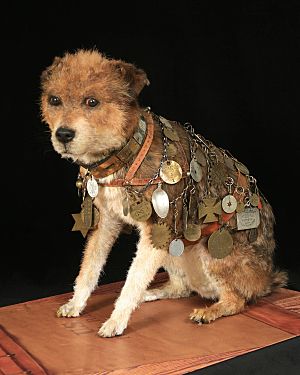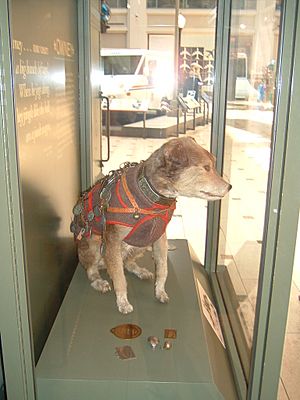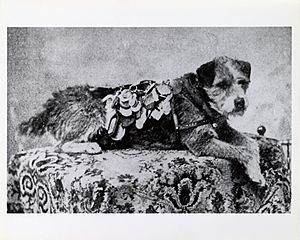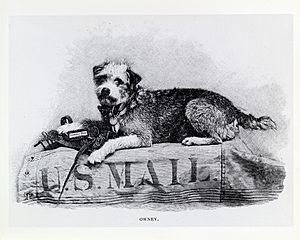Owney (dog) facts for kids

Owney as displayed at the National Postal Museum
|
|
| Other name(s) | Owney, the Postal Dog |
|---|---|
| Species | Dog |
| Breed | Border terrier |
| Sex | Male |
| Died | June 11, 1897 (aged 10 est.) Toledo, Ohio |
| Resting place | Smithsonian Institution 38°53′53″N 77°00′30″W / 38.898°N 77.0083°W |
| Occupation | Railway Mail Service, Railway Post Office Guardian, Traveller |
| Employer | U.S. Post Office |
| Notable role | Companion |
| Years active | 1887–1897 |
| Owner | Mail Clerk, Albany, New York |
Owney (born around 1887 – died June 11, 1897) was a special terrier mix dog. He became the first unofficial mascot for the Albany, New York, post office around 1888. Mail workers loved him and recommended him to their friends in the Railway Mail Service. For nine years (1888–1897), Owney was a mascot for the entire country. He traveled all over the United States and even went around the world! He journeyed over 140,000 miles in his lifetime. Owney is famous for being honored with a U.S. postage stamp in 2011.
Owney: The Amazing Postal Dog

Owney's Early Days
Owney originally belonged to a postal clerk in Albany. The dog often came to work with his owner. Owney really loved the smell of the mail bags. He would often sleep right on top of them. When his owner left the post office, Owney stayed. Everyone knew he was happier there with the mail.
Owney usually slept on the mail bags. When the bags were moved, Owney went along for the ride. Postal railway clerks thought he brought good luck. No train he rode on ever had a wreck! He was always welcome in any railway post office. Owney was a loyal guardian of the mail. He would not let anyone except mail clerks touch the bags.
This was a very important job for Owney. The Albany train station was a key spot for the New York Central Railroad. This was one of the biggest railroads in the U.S. at the time. Mail trains from Albany went to Boston, New York City, and west to Chicago. A book from that time said Owney traveled everywhere. He was tagged, petted, and looked after like family. Sometimes he would disappear for months. In 1893, people worried he was dead. But it turned out he had been in an accident in Canada.
As Owney's trips got longer, the Albany postal clerks worried about him. They wanted to make sure he could be identified. So, they bought him a dog collar with a metal tag. It said: "Owney, Post Office, Albany, New York." As Owney traveled, different railway post offices added their own dog tags to his collar. This made him the unofficial mascot of the U.S. Railway Mail Service. These tags became a big part of his identity.
Owney received tags everywhere he went. They jingled like sleigh bells when he moved. In 1893, he got a medal for "Best Traveled Dog." This was from Winnona Kilbridge of the Los Angeles Kennel Club. In 1894, he received a "Globe Trotter" medal from Mr. William Winter Wagner of Chicago. His collection of tags grew very large. The United States Postmaster General, John Wanamaker, even gave him a special coat to show them all off. Wanamaker also announced that Owney was now the Official Mascot of the Rail Mail Service.
We don't know the exact number of tags Owney received. The mass of tags became too heavy for the small dog to carry. Clerks would remove tags and send them to Albany or Washington D.C. for safekeeping. One source says he received 1,017 medals and tokens. Some of these tags are now lost. The National Postal Museum has 372 of Owney's tags. Other items related to Owney are also on display there.
Owney once did something very special. A mail pouch accidentally fell out of a wagon during a delivery. Owney stayed behind to protect it. When the clerks returned to the main Post Office, the bag and Owney were missing. They went back and found Owney lying on top of the mailbag. He guarded the mail pouch until someone from the Post Office arrived.
A Dog's World Tour
One of Owney's most famous trips was to Montreal, Quebec, Canada. The postmaster there kept him in a kennel. A bill for $2.50 for his food was sent to Albany, New York. The money was collected, and Owney was sent back home.
The Universal Postal Union was created in 1874. It helped make international mail shipping the same everywhere. More and more countries joined this agreement. This made it possible for Owney to travel even further. In 1895, Owney went on an around-the-world trip! He rode with mail bags on trains and steamships. He started from Tacoma, Washington, on August 19. For four months, he traveled through Asia and Europe. He returned to New York City on December 23.
When he came back during Christmas week, the Los Angeles Times reported his journey. It said he visited Asia, North Africa, and the Middle East. Another report claimed the Emperor of Japan gave Owney two passports. He also received several medals with the Japanese coat of arms. Owney's big return to America was in newspapers across the country. He became world-famous after this amazing trip.
Remembering Owney
As Owney got older, the Post Office thought his traveling days should end. A mail clerk named J. M. Elben in St. Louis agreed to take care of him. Owney had traveled over 143,000 miles in his life.
Sadly, Owney passed away in June 1897. Newspapers across the country shared the sad news. They reported that Owney had been sick and became aggressive in his old age. In Toledo, Ohio, a difficult decision was made, and Owney's life ended. The Chicago Tribune called it "an execution." Postal workers were very sad about his death. They refused to bury their beloved mascot. Clerks from all over the country wanted Owney to be honored. They asked that his body be preserved and sent to the Post Office Department's main office.
Owney's remains were preserved through taxidermy. In 1904, a display of Owney was shown by the Postal Service. This was at the St. Louis World's Fair. Postal workers in Cleveland, Ohio, even had a special silver spoon made to remember him.
Owney is now part of an exhibit at the Smithsonian Museum. He was sent there in 1911. He is known as one of the museum's "most interesting" artifacts. Over the years, his preserved body needed some care. In 2011, he and his tags were given a big makeover. A Smithsonian employee called the finished work "the big reveal."
On July 27, 2011, the United States Postal Service released a forever stamp honoring Owney. The artist, Bill Bond, wanted to show Owney as "spirited and lively." He ended up working from Owney's preserved body. Owney was also honored at the Albany, New York post office. The stamp was even part of a special augmented reality app. You could use it on Windows, Apple iPhone, iPad 2, and iPod Touch.
Like Bob the Railway Dog, a famous Australian dog from that time, Owney was also the subject of poetry. A clerk in Detroit wrote:
- Owney is a tramp, as you can plainly see.
- Only treat him kindly, and take him 'long wid ye."
Another clerk in Minnesota wrote:
- "On'y one Owney, and this is he;
- the dog is aloney, so let him be."
Owney has been the main character in five hardcover books. The National Postal Museum also published an e-book in 2012. It is called Owney: Tales from the Rails. It was written by Jerry Rees with songs by Stephen Michael Schwartz. Fred Cline did the illustrations. The book is narrated, and the songs are performed by Trace Adkins. You can find more at http://www.npm.si.edu/owneyebook/



